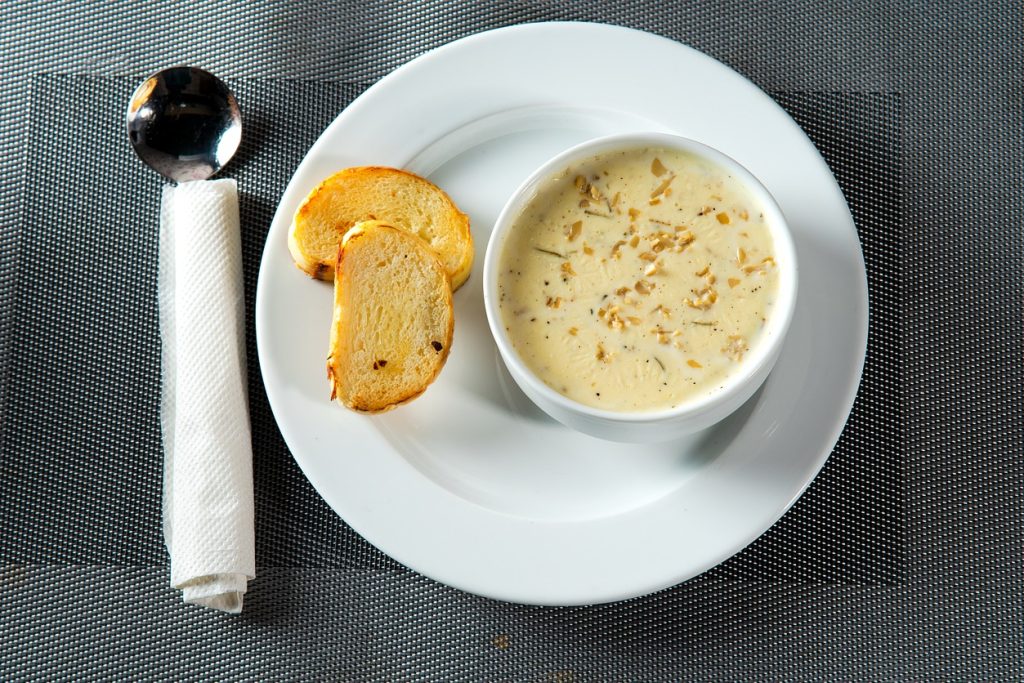Clam chowder is a popular and hearty soup made with clams, potatoes, onions, and milk or cream. It is a comforting dish that is enjoyed by many, especially on a cold winter day. One of the challenges when making clam chowder is achieving the desired thickness and consistency. Some like it thick and creamy, while others prefer a thinner broth. This article will discuss various methods to thicken clam chowder to achieve the perfect texture.
How To Thicken Clam Chowder?
Here are 5 ways to thicken clam chowder:
1. Roux
A roux is a mixture of equal parts fat (usually butter) and flour that is used to thicken sauces and soups. To use a roux to thicken clam chowder, start by melting butter in a saucepan over medium heat. Once the butter has melted, add an equal amount of flour and whisk until it forms a paste. Cook the roux for a few minutes to cook out the raw flour taste, constantly stirring to prevent burning.
Once the roux has cooked, gradually whisk in some of the clam chowder broth, a little at a time, until the mixture is smooth. Then pour the roux mixture back into the main pot of clam chowder and stir to combine. Allow the soup to simmer for a few minutes to thicken, and adjust the seasoning if necessary.
2. A Cornstarch Slurry
A cornstarch slurry is another effective way to thicken clam chowder. To make a cornstarch slurry, mix cornstarch and water together until it forms a smooth paste. The general ratio is 1 tablespoon of cornstarch to 1 cup of liquid.
Once the slurry is made, pour it into the soup pot and stir to combine. Allow the soup to simmer for a few minutes to thicken, and adjust the seasoning if necessary.
Note: Cornstarch can break down if overcooked or reheated, so it’s best to use this method if you plan to serve the soup immediately.
3. Heavy Cream
Heavy cream is a classic ingredient used in clam chowder and helps thicken the soup. Add heavy cream to the soup pot and stir to combine. Allow the soup to simmer for a few minutes to thicken, and adjust the seasoning if necessary.
Note: Be careful not to add too much cream, as it can overpower the other flavours in the soup and make it too rich.
4. Use Mashed Potatoes
Potatoes are a key ingredient in clam chowder but can also be used to thicken the soup. Start by cooking peeled and chopped potatoes in a separate pot until they are soft. Mash the potatoes until they are smooth, then add them to the soup pot. Stir to combine and allow the soup to simmer for a few minutes to thicken and adjust the seasoning if necessary.
Note: This method will change the flavour of the soup slightly, making it taste more potato-like.
5. Bread
Bread is a lesser-known thickening agent that can be used in clam chowder. To use bread, start by tearing a few slices of bread into small pieces and soaking them in milk or cream. Once the bread has soaked up the liquid, add it to the soup pot and stir to combine. Allow the soup to simmer for a few minutes to thicken, and adjust the seasoning if necessary.
Note: This method will also change the flavor of the soup slightly, making it taste more bread-like.
One thing to remember when thickening clam chowder is that it will continue to thicken as it cools. Therefore, it’s best to err on the side of caution and use less thickener than you think you need. You can always add more later if needed.
It’s also important to note that different types of clam chowder may require different thickeners.
For example, New England-style clam chowder is typically thicker and creamier than Manhattan-style clam chowder, which has a thinner tomato-based broth. Be sure to consider the style of clam chowder you are making when choosing a thickener. In addition to the methods listed above, you can use some tips and tricks to thicken clam chowder naturally. For example, cooking the soup uncovered for a longer period of time will allow some of the liquid to evaporate and the soup to thicken. Adding more potatoes to the soup will also help thicken it naturally.
Next, let’s look at the recipe.
Thick Clam Chowder Recipe
This thick clam chowder recipe is perfect for those chilly evenings when you need something warm and comforting to fill your belly. With a creamy base and tender clams, it’s sure to be a hit with anyone who loves seafood.
Ingredients
- 1/2 lb salt pork, diced
- 2 onions, chopped
- 3 celery stalks, chopped
- 3 potatoes, peeled and diced
- 2 cups clam juice
- 2 cups heavy cream
- 2 cans chopped clams, drained
- 2 tbsp butter
- 2 tbsp flour
- Salt and pepper to taste
Directions To Prepare
- In a large pot, cook the diced salt pork until it is brown and crispy. Remove the pork from the pot and set it aside.
- In the same pot, sauté the chopped onions and celery until tender.
- Add the diced potatoes to the pot along with the clam juice. Bring the mixture to a boil, then reduce the heat and let it simmer until the potatoes are cooked through.
- Add the heavy cream and drained chopped clams to the pot and stir everything together.
- In a separate pan, melt the butter and then stir in the flour to make a roux. Cook the roux for a few minutes until it turns a light brown color.
- Add the roux to the pot and stir it in well. Let the chowder simmer for a few minutes until it thickens to your desired consistency.
- Season the chowder with salt and pepper to taste.
- Serve the chowder hot, topped with the crispy salt pork pieces.
There are many ways to thicken clam chowder, and each method will change the flavour and texture of the soup slightly. The best method will depend on your preference and the ingredients you have on hand. Whether you choose to use a roux, cornstarch slurry, heavy cream, mashed potatoes, or bread, the key is to add the thickener slowly and allow the soup to simmer for a few minutes to thicken and develop the flavours.
Feature Image: Pixabay
More Reads:





